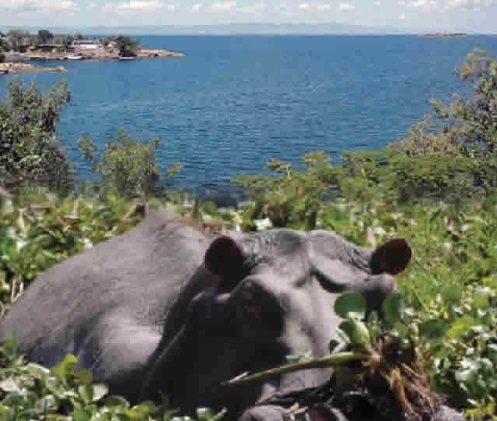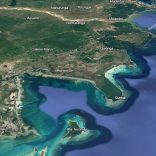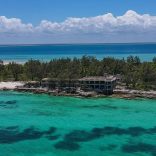Millennium bim joins the 'Mozambique 50 Years of Independence' exhibition at the Camões Gallery
Water hyacinth chokes Lake Kariba

Southern African News
The massive growth of water hyacinth (Eichhornia crassipes) which can double its mass every four days could choke and affect the long-term water availability on Lake Kariba, the world’s biggest man made reservoir, environmental researchers warn.
According to the latest, Zambezi Environment Outlook 2015 report running under the theme: “Towards strengthening basin-wide cooperation and regional integration,” researchers say that the invasion of the lake by the water hyacinth, with its characteristic thick-floating mats was also another contributing factor to the reduced water levels on the lake.
The Outlook highlights the state and trends of key environmental resources, including land, freshwater, marine and coastal resources, forests and woodlands, and wildlife of a single ecosystem of the Zambezi Basin.
The report shows that there has been changes to the state of the environment in the Zambezi Basin during past 15 year since a comprehensive assessment of the basin was published in 2000.
“The weight of the water hyacinth is mainly water and the plant can double its mass every four days or so given warm eutrophic conditions,” the report noted.
“Thus, the plant actively pumps water through its tissues and releases it into the air in the process of evapotranspiration. Through this process the water loss from the surface of water bodies with invasive species is more than triple that from the same water bodies without these plants.”
Lake Kariba straddles Zimbabwe’s border with Zambia, generating hydropower for both southern African countries, but falling water levels have forced the two nations to cut power production.
The study , conducted by researchers from Southern African Research and Documentation Centre (SARDC) through its I. Musokotwane Environment Resource Centre for Southern Africa (IMERCSA) for the Zambezi Watercourse Commission (ZAMCOM), is an update of the State of the Environment Zambezi Basin 2000 report.
It looks at all types of human intervention on freshwater – from dams and reservoirs to irrigation and pollution. It paints a devastating picture of how the Zambezi River which together with its tributaries, forms the fourth largest river basin in Africa after the Congo, the Nile, and the Niger River basins, covering about 4.5 percent of the continent, is declining.
The Zambezi River Basin drains an area of almost 1,4 million square kilometres, stretching across eight of the 15 Member States of the Southern African Development Community (SADC) – Angola, Botswana, Malawi, Mozambique Namibia, Tanzania, Zambia and Zimbabwe.
The study noted with concern the massive growth of the dense green mat of leaves that choke the shoreline of the lake which has reduced water levels, caused difficulties in water extraction and generation of power and reduced fish catches.
In addition, the Zambezi Environment Outlook 2015 notes that the basin has been characterised by declining water quality, depletion of groundwater and a surge in aquatic invasive species.
It notes that there will be more changes in rainfall patterns in the basin and that a decrease by 10-15 percent in rainfall is expected by 2050.
Water hyacinth is suspected to have originated from South America and is one of the world’s most widespread invasive aquatic plants.
The plant grows very fast and rapidly depletes nutrients and oxygen from water bodies, adversely affecting flora and fauna.
Researchers say the two main species of invasive aquatic plants on Lake Kariba are the water hyacinth (Eichornia Crassipes) and the Kariba weed (Salvinia Molesta).
“The proliferation of these invasive plants on Lake Kariba poses operational problems for hydropower production if the weeds get into the hydropower or domestic water supply intake. Lake navigation and fisheries are also negatively affected,” the study noted.
The Kariba weed, researchers say, first became a ‘real nuisance’ in 1994 when the lake remained at levels lower than normal due to the prolonged below-normal water inflows.
The Zambezi River Authority (ZRA) implemented a programme for reducing and controlling the proliferation of the water hyacinth through an extensive aerial spraying in August 1998, using the phenoxy herbicide 2,4-D at the rate of 6 litres/ha.
“Water and fish samples were taken before, during and after the spraying exercise to determine any detrimental effects. None were detected and this spraying exercise is well-documented (ZRA1999),” according to the report.
“The spraying of the water hyacinth with 2,4-D was very effective and caused the death and submergence of the treated water hyacinth within one week.”
A total of 1, 671ha were cleared of the water hyacinth followed by a biological control programme using weevils (Neochetina spp.) on the remaining areas infested by water hyacinth which could not be sprayed, such as at domestic water intake works.
Researchers observed that this strategy worked well and the water hyacinth growth and proliferation was put under control.
However, increased human activity and pollution in the Zambezi River Basin has led to the fierce re-emergency of the Kariba weed.
Researchers say the increase in pollution discharges is largely attributed to urbanisation, increased industrial and agricultural activities, mining and soil erosion.
Urban centres dotted around the Zambezi River Basin produce sewage effluent while their industries produce toxic wastes.
Gold panning in the Basin together with the agricultural sector which uses fertilizers and other pesticides have all contributed to the pollution of the surface and groundwater resources.
“Mine wastes, if not disposed and managed properly, result in heavy metal water pollution,” the study noted.
“The situation is worsened by the fact that the riparian states of the Zambezi River do not have harmonised water quality and effluent standards.”
The Outlook 2015 points that due to economic growth in the Zambezi riparian states as well as growing populations and urbanisation, the pollution of water bodies and the environment is increasing which in turn increases costs for water purification and production of goods and services.
“As the land area under irrigation increases due to population growth, emerging demand for bio-fuels and decline in soil fertility, for example, more fertilizers and pesticides are being used with residues finding their way into underground and surface waters,” the study noted.
“This results in eutrophication of water bodies requiring expensive remedies.”
Water pollution is now a major threat to the water resources of the Zambezi River and is negatively affecting aquatic life and ecosystems in general by degrading the water quality.
It has worsened the eutrophication of lakes and reservoirs, which then increases the growth of evasive aquatic weeds causing further negative impact on the utilization of the water body.
“Effluent discharge is also a matter of concern in the Zambezi Delta. The Sena Sugar industry at Marromeu releases high amounts of biodegradable waste and high amounts of wastewater into the Zambezi water system,” the study noted.
“The effluents are likely to increase organic loading in the Zambezi River, thus negatively affecting the aquatic ecosystem. In Harare, the Mukuvisi River that drains into Manyame is generally considered the most heavily polluted river system in Zimbabwe. The river flows through both industrial and residential areas of Harare.”
Researchers found out that the infestation of the Zambezi Basin by aquatic weeds is a problem of regional scale, which has occurred in several sub basins, such as Kafue, Lake Kariba, Lake Chivero, Kwando-Linyanti and the Lower Shire.
“Waterweeds thrive when nutrients are present in comparatively high concentrations and are therefore a problem closely related to eutrophication. In some watercourses, eg Lake Chivero in Zimbabwe, Kafue Gorge Reservoir in Zambia and Lake Kariba, this problem had reached critical levels until pragmatic mitigation measures were undertaken. Attention is therefore now focused on causative factors such as land use on the upstream catchment,” the report says.
In addition to the water hyacinth, the presence of an invasive Australian crayfish is spreading and multiplying in the Lake Kariba waters at a faster rate than previously thought, according to the report.
The study indicates that the invasive predator, introduced into the lake after escaping from fish farms in Zambia in 2002 could be inflicting more damage than previously thought, as it hunts shoals of the small Tanzania sardines commonly known as kapenta, a dominant source of fish protein in Zimbabwe.
Marine experts say crayfish eat almost anything, including plants, invertebrates, snails, small fish, fish eggs and even its own offspring.
“The alien species have been breeding out of control, devouring food sources of all fish breeds, including bream, whose population has also been extensively decimated,” according to the Outlook 2015 report.
Fish growth and reproduction has been impaired. According to reports, the Parks and Wildlife Management Authority of Zimbabwe said that kapenta output plunged to 8,746 tonnes in 2013 from 19,957 tonnes in 1993.
This reduced fish stock has deprived local people of a major source of livelihood while the weed mats also harbour crocodiles and snakes, making it difficult for locals to access water for use.
Weeds are one of the major threats to the natural environment. They are destroying native habitats, threatening native plants and animals and choking our natural systems including rivers and forests
This has also affected the livelihood of communities who depend on the lake for food, drinking and irrigation water, energy and a means of transport.
Importance of Lake Kariba is at the centre of a large number of communities. Bordered by Zimbabwe and Zambia, it is the largest man-made lake in the world, with a surface area of almost 5,400 km².
Efforts to fight water hyacinth on Lake Kariba and other basins in Zimbabwe and Zambia have focused on the use of mechanical and biological means.
Chemical control was least favoured, owing to the potential damage that herbicides could do to the lake and agriculture.
Harnessing of the weed for the making of handicrafts, though useful, has not helped to reduce the proliferation of the Kariba weed.
Enterprising locals have found that the invasive plant can be a free source of material for making handicrafts such as handbags, furniture and other wares.
This has created employment to disadvantaged women, youths and those with disabilities. .
But the battle against weeds is too big and complicated.
As there is no solution in sight, a 2010 UN report says the world’s rivers are so badly affected by human activity that the water security of almost 5 billion people and the survival of thousands of aquatic species, are threatened.
Globally between 10 000 and 20 000 aquatic wildlife species are at risk or face extinction because of the human degradation of global rivers, the report further points out.












Leave a Reply
Be the First to Comment!
You must be logged in to post a comment.
You must be logged in to post a comment.